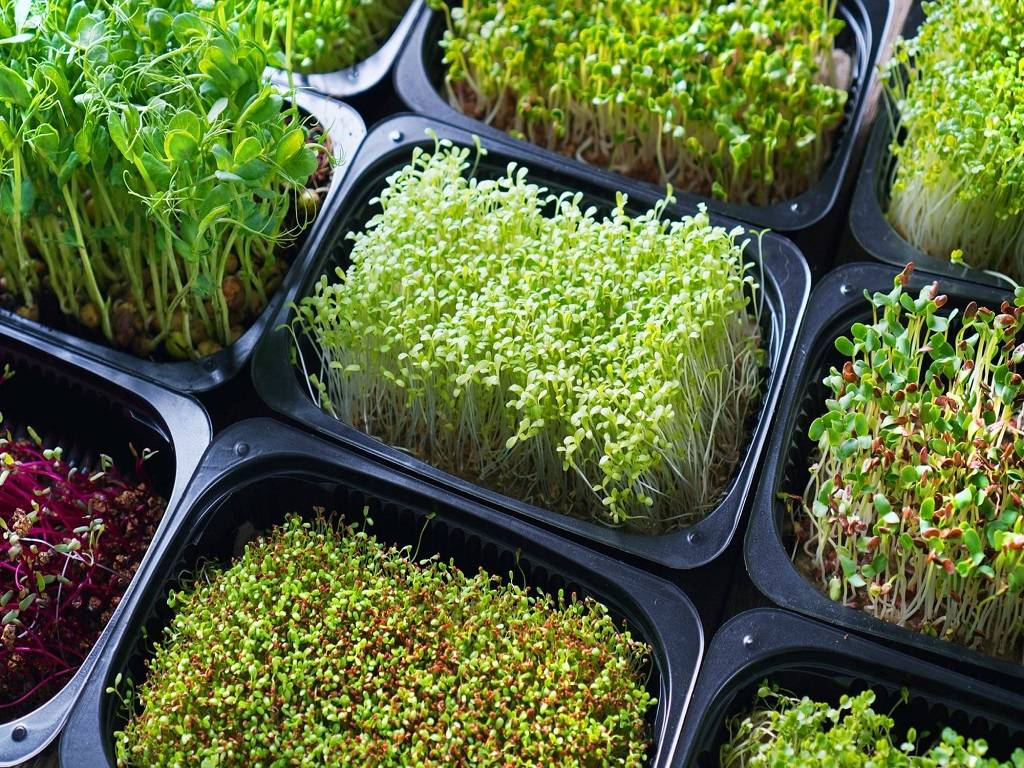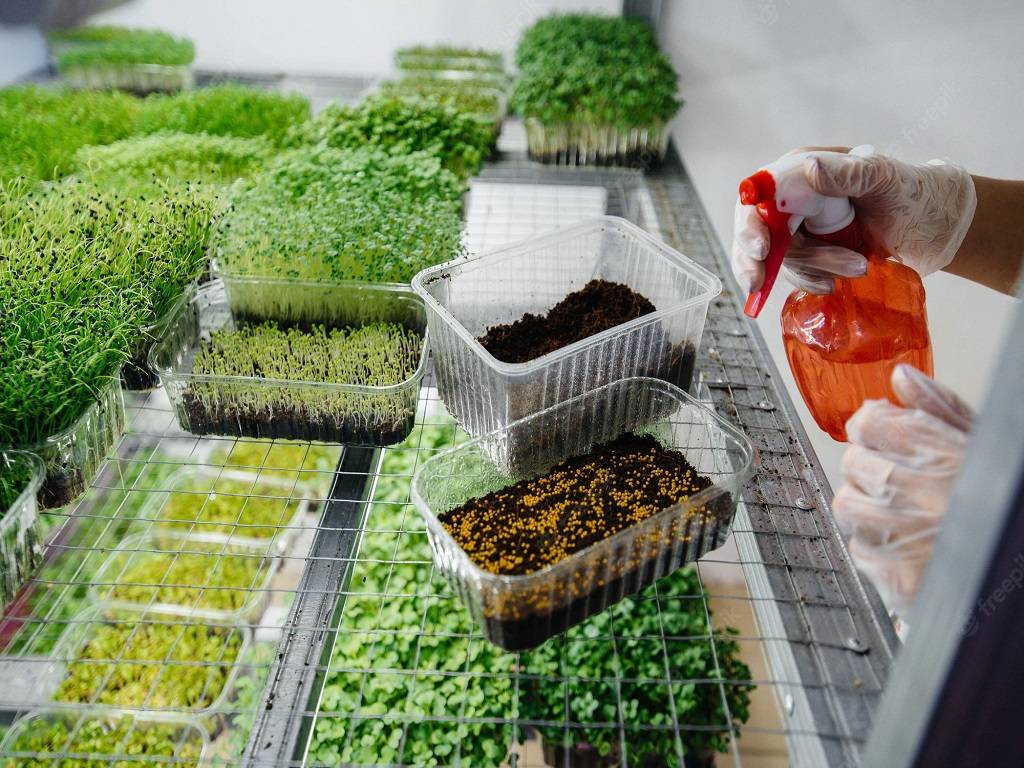
Microgreens are one of the most profitable crops you can grow in your backyard or garden. They are the perfect crop for small farms and urban gardeners because they can be cultivated in a little area and can be sold for a good price. You might be able to make six figures of income per year in a space as small as a basement, garage, or shipping container!
You can harvest and sell your first crop in only a few weeks thanks to the inexpensive setup cost and the short growing cycle. So how does one start a microgreens business and begin selling their produce?
You will learn everything you need to know to get started with this in-depth guide.
Benefits of growing Microgreens as a Business
Here are some of the prime reasons why starting a microgreens business is a great idea.
Low start-up cost: You can start a microgreens business with one or two 10" x 20" trays and grow it from there. Soil and seeds for each tray only cost around $2.
When you first start out, you can just supply one restaurant or make enough microgreens to sell once a week at a farmer's market. As demand for your product increases, you can then increase your output.
Fast turnaround time: You don't have to wait a full season or more to harvest microgreens, unlike crops like corn or wheat. Microgreens can be harvested from seed to plate in as little as one week or, at most, four weeks.
With such a quick turnaround, you can experiment and improve the productivity of your business. Should your sales fluctuate during the year, you can also adjust your production up or down quickly.
Year-round growing: Microgreens are one of the few ways a small farmer can grow food all year round without greenhouses. Another method is to grow mushrooms.
This also implies that it's a fantastic way to generate consistent money. Or, if you're already a farmer, you can employ microgreens to boost your income and expand your business over the winter.
Higher nutrition: Microgreens are superfoods. They include a variety of vitamins and minerals. They appeal to health-conscious consumers as well as to restaurants as high-end garnishes and ingredients.
High-value crop: High-price restaurants and grocery stores pay high sums for microgreens. As a local grower, you can also charge more for them because they're such a specialized product that tastes best when it's fresh.
How Much Room Do You Need to Start Growing Microgreens?
Microgreens can be grown in very little space. It's more than enough to get started if your home has a spare bedroom.
To make the most of their vertical area, the majority of microgreen growers employ racks.

Many gardeners can produce 50 lbs of microgreens every two-week cycle in a 60-square-foot space using racks with four shelves. That works out to $1,000 per cycle or almost $2,000 per month at $20 per pound.
As a result, if your business is operating, you may be able to earn $30 to $50 per square foot (or around $100 to $160 per square meter) per month.
To get there, you'll need to make some investments in equipment, optimize your growth, and establish a steady client.
Each 10" x 20" tray will normally provide 5 to 6 ounces (140 - 170 grams) of microgreens when you're just getting started and growing them on a single level, like a tabletop. This depends on what you're growing.
What Supplies do you need to start Growing Microgreens?
The basic equipment and supplies you'll need to start your microgreens business are listed below.
-
A 2-bulb, 4-foot fluorescent light fixture: Along with basic T8 fluorescent bulbs like you’d find in any shop.
-
16 10″x20X trays with drain holes: You can grow 8 flats of microgreens per week on a 4-foot setup. For further stability and strength, we advise doubling up your flats.
-
Paper towels: To put over the seeds when you start them.
-
A spray bottle: To keep your microgreens moist while they grow and to prevent the germination of your seeds from drying out.
-
Seed: We suggest you start with radish seeds as they are the simplest and grow the quickest. Investing a little more money in organic seeds is beneficial. In this manner, you may also promote your microgreens as organic.
You can order your seeds online from any site. You can find a seller by simply typing "buy radish microgreen seeds (your country)". It's essential to purchase in bulk if you want to reduce your expenses.
-
A scale: To weigh your microgreens before packaging them. You can use a standard kitchen scale.
-
A good pair of scissors or a large sharp knife: To collect your microgreens. Because harvesting will be a nightmare with a dull blade, it is worth spending a few additional dollars here.
-
Potting soil: Any high-quality organic potting soil will do.
-
A timer: To set your lights up to turn on and off at certain times.
-
A small fan: To keep your crops well-ventilated to prevent mold or other issues.
-
A cheap watering can: Get one with a really fine spout. When your microgreens are bigger, you should begin watering them rather than just misting them.
Starting A Microgreens Business
Even if you can grow microgreens well, your business won't take off unless you have some clients who are willing to purchase them from you.
Therefore, researching to determine the sustainability of your microgreens business is one of the most important steps before starting it.
Before investing the money, time, and effort only to discover that no one wants to buy your microgreens, it is far preferable to find out upfront.
Step 1: Finding Customers & Getting to Know Them
The more contacts you can make and potential buyers you can identify before your microgreens are even fully developed, the less pressure you'll feel about selling them.
You can choose from a variety of alternative sales channels. The majority of microgreen growers use a variety of channels like chefs, residential customers, farmers' markets, grocery stores, and wholesale.
Step 2: Find High-Quality Information
We would recommend investing a lot of your free time when you first start out in learning as much as you can about cultivating microgreens.
Watch YouTube videos of successful growers, buy books on Amazon, or even enroll in paid online courses.
Even while paying for online courses may cost you more upfront, they will save you a ton of time by giving you all the information you require. rather than attempting to put all the information together on your own.
Step 3: Testing New Varieties and Techniques
To identify what works best for you when you first start, you should experiment for a few weeks or months.
To determine what benefits or disadvantages your grow operation has, experiment with different types, everyday light hours, temperatures, seed density, and other factors.

Step 4: Keep Excellent Records
It's essential to have accurate records in every business. You should maintain a different sheet for each type of microgreen you grow. Include information like:
-
Seed variety and company purchased from
-
Date and time seeds were soaked
-
Date and time trays were seeded
-
Seed density per tray
-
Seed technique notes (Did you use a paper towel or leave them uncovered? How many stacks of trays)
-
Growing conditions (Light per tray, humidity, airflow, watering)
-
Harvest date and time. (Including harvest technique and yield)
Step 5: Selling Microgreens
Without selling them, it won't be considered a business. You're just wasting money like a gardener!
The simple part is actually growing the microgreens. The challenging part of selling your goods is establishing business connections. If you want to generate money, you should try to sell 90% of what you cultivate.
Split testing can help you figure out what will sell and market your product the best.
Step 6: Keep It Simple
Start with not more than one, two, or three different kinds of microgreens. Choose well-known varieties like radish, sunflower, etc.
A higher price might be demanded obscure varieties, but only if there are buyers. Focus on the essentials that will first provide you with a steady income.
Start including no more than one or two lights and not more than 20 trays every week.
You can always start growing once you start generating some sales. You may also find out what kind of microgreens chefs and your other clients want by asking them. By doing so, you can adjust your supply to satisfy their need.
















